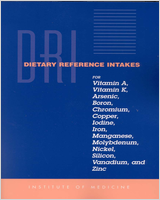From: D, Dietary Intake Datafrom the Continuing Survey of Food Intakes by Individuals (CSFII), 1994–1996

NCBI Bookshelf. A service of the National Library of Medicine, National Institutes of Health.
| Sex/Age Categorya | Number of Persons Examined | Mean | Percentile | |
|---|---|---|---|---|
| 5th | 10th | |||
| Both sexes, 0 to 6 mo | 157 | 0.61 | 0.40 | 0.44 |
| Standard error | 0.02 | 0.02 | 0.02 | |
| Both sexes, 7 to 12 mo | 112 | 0.77 | 0.49 | 0.55 |
| Standard error | 0.05 | 0.04 | 0.04 | |
| Both sexes, 1 to 3 y | 1,791 | 0.71 | 0.41 | 0.47 |
| Standard error | 0.01 | 0.01 | 0.01 | |
| Both sexes, 4 to 8 y | 1,650 | 0.88 | 0.55 | 0.61 |
| Standard error | 0.01 | 0.01 | 0.01 | |
| M 9 to 13 y | 552 | 1.17 | 0.69 | 0.78 |
| Standard error | 0.04 | 0.02 | 0.02 | |
| M 14 to 18 y | 446 | 1.45 | 0.81 | 0.92 |
| Standard error | 0.05 | 0.03 | 0.03 | |
| M 19 to 30 y | 854 | 1.52 | 0.81 | 0.92 |
| Standard error | 0.03 | 0.03 | 0.03 | |
| M 31 to 50 y | 1,684 | 1.50 | 0.84 | 0.95 |
| Standard error | 0.02 | 0.01 | 0.02 | |
| M 51 to 70 y | 1,606 | 1.44 | 0.78 | 0.89 |
| Standard error | 0.03 | 0.02 | 0.02 | |
| M 71+ y | 674 | 1.25 | 0.67 | 0.77 |
| Standard error | 0.03 | 0.02 | 0.02 | |
| F 9 to 13 y | 560 | 0.99 | 0.64 | 0.71 |
| Standard error | 0.02 | 0.02 | 0.02 | |
| F 14 to 18 y | 436 | 1.07 | 0.62 | 0.69 |
| Standard error | 0.05 | 0.04 | 0.05 | |
| F 19 to 30 y | 760 | 1.05 | 0.60 | 0.68 |
| Standard error | 0.02 | 0.02 | 0.02 | |
| F 31 to 50 y | 1,614 | 1.06 | 0.62 | 0.70 |
| Standard error | 0.01 | 0.01 | 0.01 | |
| F 51 to 70 y | 1,539 | 1.05 | 0.63 | 0.70 |
| Standard error | 0.02 | 0.01 | 0.01 | |
| F 71+ y | 623 | 1.00 | 0.56 | 0.64 |
| Standard error | 0.04 | 0.02 | 0.02 | |
| F Pregnant | 71 | 1.17 | 0.76 | 0.83 |
| Standard error | 0.06 | 0.04 | 0.04 | |
| F Lactating | 42 | 1.35 | 0.84 | 0.92 |
| Standard error | 0.11 | 0.09 | 0.09 | |
| All Individuals | 15,058 | 1.17 | 0.58 | 0.67 |
| Standard error | 0.01 | 0.01 | 0.01 | |
| All Indiv (+P/L) | 15,170 | 1.17 | 0.58 | 0.67 |
| Standard error | 0.01 | 0.01 | 0.01 | |
NOTE: Data are limited to individuals who provided two 24-hour dietary recalls and were adjusted using the Iowa State University method. Mean, standard errors, and percentiles were obtained using C-Side. Standard errors were estimated via jackknife replication. Each standard error has 43 degrees of freedom. Infants and children fed human milk were excluded from all analyses. One female was pregnant and lactating and was included in both the Pregnant and Lactating categories. The sample sizes for the Pregnant and Lactating categories were very small so their estimates of usual intake distributions are not reliable.
From: D, Dietary Intake Datafrom the Continuing Survey of Food Intakes by Individuals (CSFII), 1994–1996

NCBI Bookshelf. A service of the National Library of Medicine, National Institutes of Health.